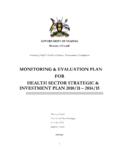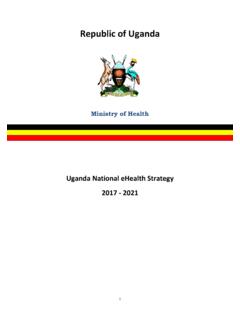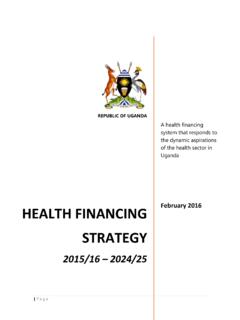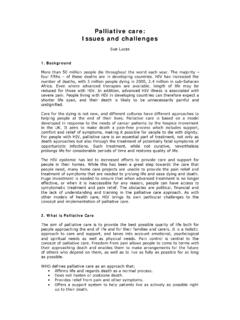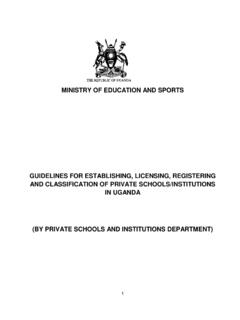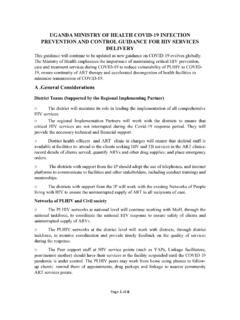Transcription of Uganda Demographic and Health Survey 2016 - Key …
1 Uganda Demographic and Health Survey 2016 Key Indicators GOVERNMENT OF Uganda Uganda Demographic and Health Survey 2016 Key Indicators Report Uganda Bureau of Statistics Kampala, Uganda The DHS Program ICF International Rockville, Maryland, USA March 2017 The 2016 Uganda Demographic and Health Survey (2016 UDHS) was implemented by the Uganda Bureau of Statistics from 15 June to 18 December 2016. The funding for the 2016 UDHS was provided by the Government of Uganda , the United States Agency for International Development (USAID), the United Nations Children s Fund (UNICEF), and the United Nations Population Fund (UNFPA). ICF provided technical assistance through The DHS Program, a USAID-funded project that provides support and technical assistance in the implementation of population and Health surveys in countries worldwide.
2 Additional information about the 2016 UDHS may be obtained from the Directorate of Population and Social Statistics, Uganda Bureau of Statistics, Collville Street, Box 7186, Kampala, Uganda ; Telephone +256-414-706-000; E-mail: Internet: Information about The DHS Program may be obtained from ICF, 530 Gaither Road, Suite 500, Rockville, MD 20850, USA; Telephone: +1-301-407-6500; Fax: +1-301-407-6501; E-mail: Internet: Recommended citation: Uganda Bureau of Statistcs (UBOS) and ICF. 2017. Uganda Demographic and Health Survey 2016: Key Indicators Report. Kampala, Uganda : UBOS, and Rockville, Maryland, USA: UBOS and ICF. iii CONTENTS TABLES AND FIGURES .. v ABBREVIATIONS .. vii FOREWORD .. ix 1 INTRODUCTION .. 1 Survey Objectives .. 1 2 Survey IMPLEMENTATION .. 3 Sample Design .. 3 Questionnaires .. 4 Anthropometry, Anaemia Testing, Malaria Testing, and Vitamin A Deficiency Testing.
3 6 Pretest .. 8 Training of Field Staff .. 8 Fieldwork .. 9 Data Processing .. 9 Community Mobilization .. 9 3 KEY FINDINGS .. 11 Response Rates .. 11 Characteristics of Respondents .. 11 Fertility .. 13 Teenage Pregnancy and Motherhood .. 14 Fertility Preferences .. 15 Family Planning .. 15 Need and Demand for Family Planning .. 18 Early Childhood Mortality .. 20 Maternal Care .. 21 Child Health and Nutrition .. 24 Anaemia Prevalence in Children and Women .. 35 Ownership and Use of Mosquito Nets .. 37 Prevalence of Malaria in Children .. 44 HIV/AIDS Awareness, Knowledge, and Behaviour .. 45 Coverage of HIV Testing Services .. 50 Sexual Violence .. 53 Early Childhood Development .. 55 Maternal Mortality .. 57 REFERENCES .. 59 v TABLES AND FIGURES Table 1 Results of the household and individual interviews.
4 11 Table 2 Background characteristics of respondents .. 12 Table 3 Current Fertility .. 13 Table 4 Teenage pregnancy and motherhood .. 14 Table 5 Fertility preferences according to number of living children .. 15 Table 6 Current use of contraception by background characteristics .. 16 Table 7 Need and demand for family planning among currently married women and sexually active unmarried women .. 19 Table 8 Early childhood mortality rates .. 21 Table 9 Maternal care indicators .. 22 Table 10 Vaccinations by background characteristics .. 26 Table 11 Treatment for ARI symptoms, fever, and diarrhoea .. 28 Table 12 Nutritional status of children .. 31 Table 13 Breastfeeding status according to age .. 34 Table 14 Anemia among children and women .. 36 Table 15 Household possession of insecticide-treated nets.
5 38 Table 16 Use of insecticide-treated nets by children and pregnant women .. 40 Table 17 Use of intermittent preventive treatment (IPTp) by women during pregnancy .. 41 Table 18 Prevalence, diagnosis, and prompt treatment of children with fever .. 42 Table 19 Hemoglobin < g/dl in children .. 43 Table 20 Prevalence of malaria in children .. 44 Table 21 Knowledge of HIV prevention methods .. 45 Table 22 Comprehensive knowledge about HIV prevention among young people .. 47 Table Multiple sexual partners and higher-risk sexual intercourse in the past 12 months: Women .. 48 Table Multiple sexual partners and higher-risk sexual intercourse in the past 12 months: Men .. 49 Table Coverage of prior HIV testing: Women .. 51 Table Coverage of prior HIV testing: Men .. 52 Table 25 Experience of sexual violence.
6 54 Table 26 Early childhood development index .. 56 Table 27 Maternal mortality .. 57 Figure 1 Trends in total fertility rate, 1988-89 13 Figure 2 Trends in unmet need, modern contraceptive use, and percentage of demand satisfied with modern methods, 1995-2016 .. 20 Figure 3 Trends in childhood mortality, 1988-89 2016 .. 2 1 Figure 4 Trends in maternal Health care, 2000-01 2016 .. 2 4 Figure 5 Nutritional status of children by age .. 33 Figure 6 Minimum acceptable diet by age, in months .. 34 Figure 7 Percentage of the de facto population with access to an ITN in the household .. 39 Figure 8 Pregnancy-related deaths per 100,000 live births .. 58 vii ABBREVIATIONS ACT artemisinin-based combination therapy AIDS acquired immune deficiency syndrome ANC antenatal care ARI acute respiratory infection BCG Bacille Calmette-Gu rin CAPI computer-assisted personal interviewing CBR crude birth rate CPR contraceptive prevalence rate CSPro Censuses and Surveys Processing DBS dried blood spot DHS Demographic and Health Survey DPT diphtheria, pertussis, and tetanus vaccine EA enumeration area ECDI Early Child Development Index GFR general fertility rate HepB Hepatitis B Hib Haemophilus Influenzae Type B HIV human immunodeficiency virus HSSP Health Sector Strategic Plan HTC HIV testing and counselling ICD-10 International Classification of Diseases-10 ICF ICF (originally, Inner City Fund)
7 IRS indoor residual spraying ITN insecticide-treated net IUD intrauterine contraceptive device LAM lactational amenorrhoea method LLIN long-lasting insecticidal nets MICS Multiple Indicator Cluster Survey NDP national development plan NGO non-governmental organisation NPHC National Population and Housing Census ORS oral rehydration salts ORT oral rehydration therapy RDT rapid diagnostic test SD standard deviations SDG Sustainable Development Goals SDM standard days method STD sexually transmitted disease TFR total fertility rate TOT training of trainers UBOS Uganda Bureau of Statistics UDHS Uganda Demographic and Health Survey UNICEF United Nations Children s Fund USAID United States Agency for International Development WHO World Health Organization ix FOREWORD he data collection for the 2016 Uganda Demographic and Health Survey (UDHS) was implemented between June 15 and December 18 2016 by the Uganda Bureau of Statistics (UBOS) in collaboration with the ministry of Health .
8 The Demographic and Health Surveys (DHS) Program is a global programme coordinated by ICF in Rockville, Maryland, USA. Technical and financial support for the 2016 UDHS was provided by the Government of Uganda , the United States Agency for International Development (USAID), the United Nations Children s Fund (UNICEF), and the United Nations Population Fund (UNFPA). The main purpose of the 2016 UDHS is to provide the data needed to monitor and evaluate population, Health , and nutrition programmes on a regular basis. Increasing emphasis by planners and policy makers on the utilisation of objective indicators for policy formulation, planning, and measuring progress has increased the reliance on regular household Survey data, given the inadequate availability of appropriate information from administrative statistics and other routine data-collection systems.
9 The UDHS provides a comprehensive overview of population and maternal and child Health issues, and the data are freely accessible to all stakeholders. The 2016 UDHS covers household and respondent characteristics, fertility and family planning, infant and child Health and mortality, maternal Health and maternal and adult mortality, child and adult nutrition, malaria, HIV/AIDS, disability, road traffic accidents, child discipline, early childhood development and domestic violence. The Survey also included measuring the height and weight of children and adults, testing children and adults for anaemia, and testing children for malaria and vitamin A deficiency; these measures will provide data for analysis of nutrition indicators throughout the country. Special thanks to the Steering and Technical working committees that oversaw the implementation of the 2016 UDHS.
10 I would like to thank the Management and staff of UBOS that was involved in the Survey , through coordination, implementation or monitoring according to the UBOS Strategic Plan. I would also like to thank all the respondents and the community that participated in providing information during the Survey field work. This Key Indicators Report is a preliminary report of key findings that UBOS has produced, with technical assistance from ICF. Ben Paul Mungyereza Executive Director T 1 1 INTRODUCTION he Uganda Bureau of Statistics (UBOS) conducted the sixth Uganda Demographic and Health Survey (UDHS) from June 15 through December 18 2016, with a nationally representative sample of over 20,000 households. All women age 15-49 in selected households were eligible for individual interviews. In a subsample (one-third) of households, all men age 15-54 were eligible for individual interviews.

